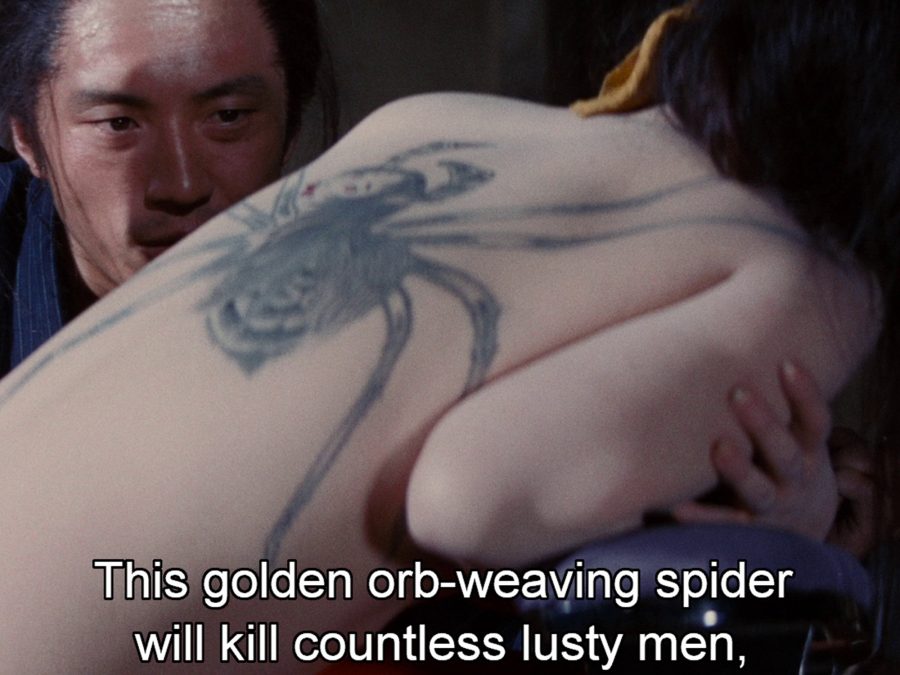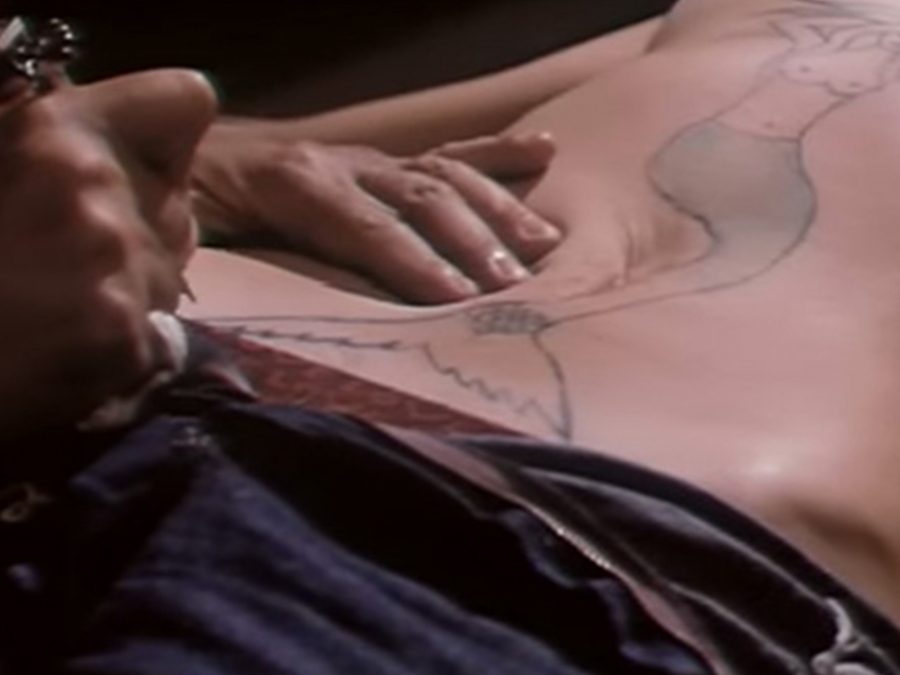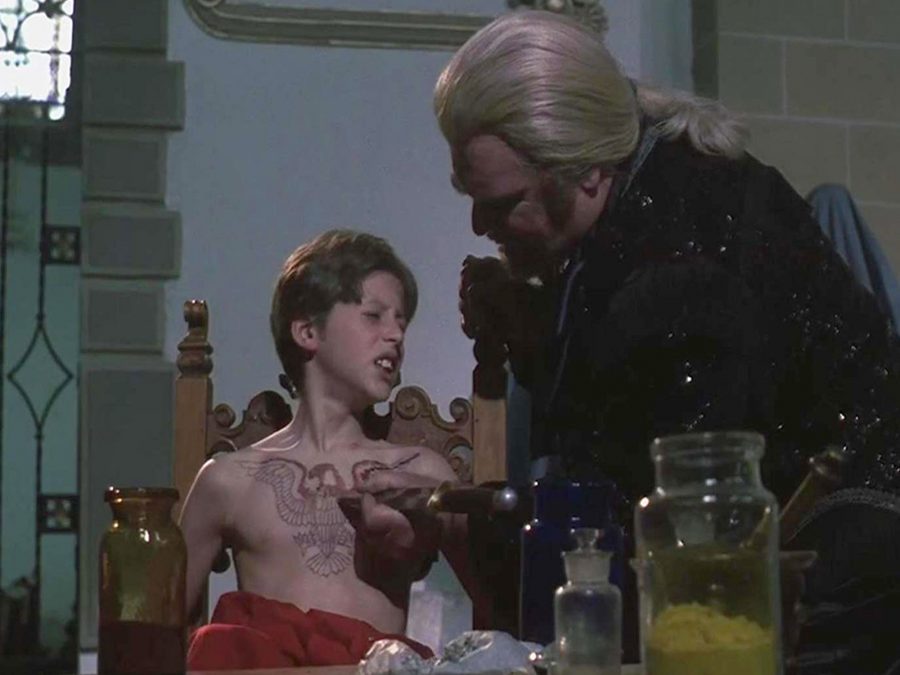[dropca]W[/dropcap]hen Stu (Ed Helms) wakes up in a Bangkok bathroom in The Hangover Part II, he has a sore head not just because of his stinking hangover but also because of the tribal mark scraped into his face the night before. The 2011 comedy’s perspective on tattooing is typical of cinema and underscores a recurrent societal concern about the practice: permanence.
Echoed in such scenes are all the questions tattooed people are asked by their unspoiled peers: you know that’s there forever, right? Isn’t that irresponsible? What’s it going to look like when you’re older? (Yes, no, and sick, thanks.) In horror, though, tattoo scenes make their mark not just with conservative scare tactics but through familial trauma and gendered violence.
In Yasuzo Masumura’s 1966 Japanese gothic Irezumi (Japanese for “Tattoo”), Otsuya is sold to a geisha house and told by its owner to “feed on men” to make him rich. Captured in stunning close-ups, her milk-white skin is then branded by master artist Seikichi, who hand-pokes across her back a golden orb-weaving spider with a grotesque woman’s face.
The spider, Seikichi says, “will kill countless lusty men” and Otsuya “will gorge on their corpses”. Otsuya becomes a man-eater, spinning webs, laying traps and leaving a trail of broken, bloodied men in her wake. She blames the spider for her actions, even after wielding the blade herself.
The film connects contemporary fears about body art and women’s sexual liberation to the folkloric spider jorōgumo, a shapeshifter said to take the form of a beautiful woman in order to ensnare men. Irezumi toys with the supernatural, asking whether it’s the vengeful sex slave or the blood-sucking spider that is the movie’s true monster. It’s neither. “Men have made me this way,” says Otsuya.

The Witch Who Came from the Sea is no different. In the opening scenes of this dreamlike “video nasty” from 1976, protagonist Molly and her nephews pass a shady-looking boardwalk parlour. “You don’t want tattoos,” she says. “They don’t come off.” But didn’t Grandpa have tattoos? “No,” says Molly. “He couldn’t have. He was a good man.” As Molly rambles about her “untouched” and “perfect” father, the camera lingers on a mermaid design in the shop window.
After several sequences of sexual violence wrought against male bodies, Molly has the mermaid inked across her abdomen. Its meaning is manifold: beauty and beast; love and violence; calm waters and raging tempests. Molly doesn’t flinch as she’s being tattooed but, as she talks wistfully about getting “lost at sea” with her father, the film flashes back to deafeningly silent scenes of two people having sex, their identities unclear.
The root of Molly’s mania is disclosed in the climactic flashback, in which an infant Molly is raped by her father, whose climax causes him to have a heart attack and collapse on top of her. When she rolls away her father’s corpse, we see the mermaid across his own abdomen. Here, the tattoo is a kind of transfer, a graphic expression of a psychological imprint. They don’t come off indeed.

Jack Dracula, the film’s tattoo artist, looks every bit the seaside creep, but at least his parlour has a bed. In Santa Sangre, Alejandro Jodorowsky’s surrealist Mexican giallo from 1989, things are a little more primitive.
“Stop crying like a little girl,” says Orgo to his young son, Fenix. “I’ll give you a charm. That’ll make you a man.” Orgo, a circus impresario, lothario and knife-thrower, binds Fenix to a wooden chair and applies a tattoo, stick-and-poke style, with a knife dipped in ink. When it’s over, Fenix has an eagle spread across his chest, just like his dad. “There. Now you’re a man.”
But Orgo isn’t “a man” for much longer. When he’s caught carrying on with his target girl – tall, intensely sexual and tattooed from face to feet – Fenix’s mother mutilates him by pouring acid on his crotch. Orgo lops off her arms in retaliation, before slashing his own throat in front of Fenix.
As an adult, Fenix suffers hallucinations and roleplays as his parents – the film is like a flash sheet of Freudian theories. (Fenix is played by Jodorowsky’s sons Adán and Axel – make of that what you will.) In the end, Fenix expels the ghosts of his past and his eagle, symbolically at least, flies away – trauma exorcised.

These horror films depict the tattooed as deviants, and many more movies reveal a deep distrust of – or disgust with – the people at either end of the needle, but few go so far as to depict them as actual demons.
In Little White Lies editor David Jenkins’ rapturous review of Evil Dead Rise, he celebrates director Lee Cronin’s “desire to make each body a new canvas for some sick-making mutilation”. Once again, “canvas” is the operative word. Ellie is a single mother of three and a self-employed tattoo artist – in that order. When we meet her, she is making adjustments to her tattoo machine while fielding questions from daughter Bridget. Parenting is clearly infringing on her career, and the scene quietly sets up one of the movie’s most significant scares.
When Ellie becomes a conduit for an ancient and gleeful evil, it has a radical effect on her attitude to motherhood. “I’m free now,” she tells Bridget. “Free from all you titty-sucking parasites.” Then, Ellie makes Bridget her canvas. The possessed matriarch snatches her tattoo machine and plunges it into her own temple, effectively dipping the needle in demon ink, before raking it across her daughter’s face.
While many films feature women as the recipients of tattoos and/or victims of tattooists, few let women wield this intimate power themselves. The machine is the tool with which Ellie earns money to raise her kids. It embodies the career she might have had had she not had children, which in the US – and many other countries – has a dramatic impact on women’s career plans and earnings. Here, Ellie is thrusting into the face of her “parasitic” offspring years of unexpressed rage, unrewarded self-sacrifice, and resentment about a life unlived – trauma exercised. As in The Witch Who Came from the Sea and Santa Sangre, the assault represents a transferral. Soon after, the ink spreads beneath Bridget’s skin until it gushes from her orifices and she too becomes a demon. Mother has infected daughter.
As Ellie’s possession intensifies, it is evident that her transformation is more literal than that of the spider-tattooed Otsuya in Irezumi. Not only does Ellie crawl around on the ceiling but, by the finale, she is literally a spider-like creature.
As in Cronin’s 2019 debut feature, The Hole in the Ground, the horror of Evil Dead Rise hinges upon a freaky infestation within the family unit. The mother-daughter tattoo reflects familial anxieties in the household, in the mind and in the body. Tattoos hurt but nothing gets under the skin like a mother’s scorn.
The post That inking feeling: Evil Dead Rise and the horror of tattoos appeared first on Little White Lies.


0 Comments